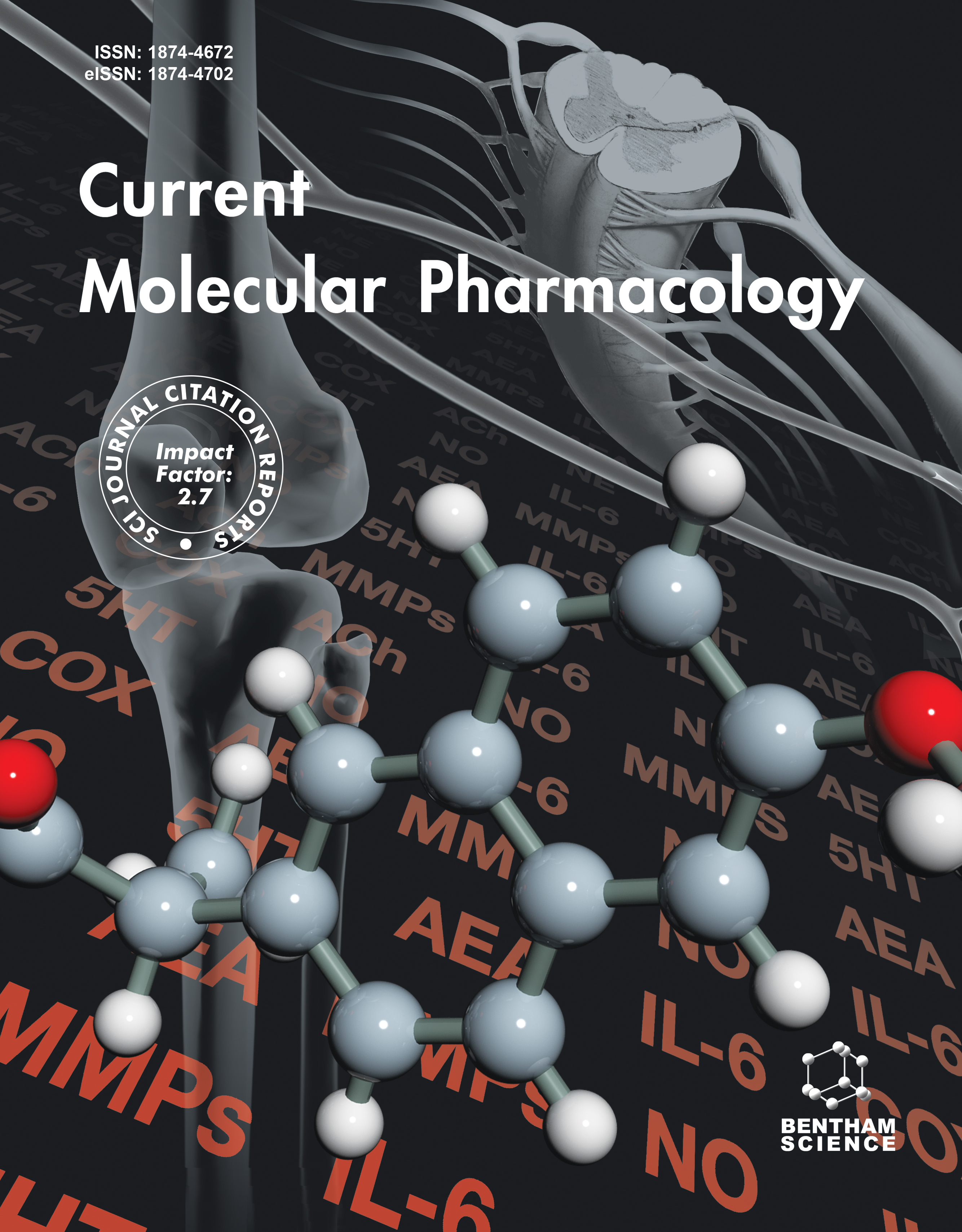- Home
- A-Z Publications
- Current Molecular Pharmacology
- Previous Issues
- Volume 16, Issue 2, 2023
Current Molecular Pharmacology - Volume 16, Issue 2, 2023
Volume 16, Issue 2, 2023
-
-
Endoplasmic Reticulum Stress and Renin-Angiotensin System Crosstalk in Endothelial Dysfunction
More LessBackground: Vascular endothelial dysfunction (VED) significantly results in catastrophic cardiovascular diseases with multiple aetiologies. Variations in vasoactive peptides, including angiotensin II and endothelin 1, and metabolic perturbations like hyperglycaemia, altered insulin signalling, and homocysteine levels result in pathogenic signalling cascades, which ultimately lead to VED. Endoplasmic reticulum (ER) stress reduces ni Read More
-
-
-
Preventive and Therapeutic Aspects of Migraine for Patient Care: An Insight
More LessAuthors: Ruchi Tiwari, Gaurav Tiwari, Sonam Mishra and Vadivelan RamachandranBackground: Migraine is a common neurological condition marked by frequent mild to extreme headaches that last 4 to 72 hours. A migraine headache may cause a pulsing or concentrated throbbing pain in one part of the brain. Nausea, vomiting, excessive sensitivity to light and sound, smell, feeling sick, vomiting, painful headache, and blurred vision are all symptoms of migraine disorder. Females are more affected by Read More
-
-
-
The Neuropharmacological Effects of Magnolol and Honokiol: A Review of Signal Pathways and Molecular Mechanisms
More LessAuthors: Xiaolin Dai, Long Xie, Kai Liu, Youdan Liang, Yi Cao, Jing Lu, Xian Wang, Xumin Zhang and Xiaofang LiMagnolol and honokiol are natural lignans with good physiological effects. As the main active substances derived from Magnolia officinalis, their pharmacological activities have attracted extensive attention. It is reported that both of them can cross the blood-brain barrier (BBB) and exert neuroprotective effects through a variety of mechanisms. This suggests that these two ingredients can be used as effective therapeutic Read More
-
-
-
Ferulic Acid Attenuates Kainate-induced Neurodegeneration in a Rat Poststatus Epilepticus Model
More LessBackground and Aims: Increasing research evidence indicates that temporal lobe epilepsy (TLE) induced by kainic acid (KA) has high pathological similarities with human TLE. KA induces excitotoxicity (especially in the acute phase of the disease), which leads to neurodegeneration and epileptogenesis through oxidative stress and inflammation. Ferulic acid (FA) is one of the well-known phytochemical compounds that hav Read More
-
-
-
Thymoquinone Attenuates Retinal Expression of Mediators and Markers of Neurodegeneration in a Diabetic Animal Model
More LessBackground: Diabetic retinopathy (DR) is a slow eye disease that affects the retina due to a long-standing uncontrolled diabetes mellitus. Hyperglycemia-induced oxidative stress can lead to neuronal damage leading to DR. Objective: The aim of the current investigation is to assess the protective effects of thymoquinone (TQ) as a potential compound for the treatment and/or prevention of neurovascular complications of Read More
-
-
-
Sodium Valproate Modulates the Methylation Status of Lysine Residues 4, 9 and 27 in Histone H3 of HeLa Cells
More LessBackground: Valproic acid/sodium valproate (VPA), a well-known anti-epileptic agent, inhibits histone deacetylases, induces histone hyperacetylation, promotes DNA demethylation, and affects the histone methylation status in some cell models. Histone methylation profiles have been described as potential markers for cervical cancer prognosis. However, histone methylation markers that can be studied in a cervi Read More
-
-
-
EGFR Inhibitor CL-387785 Suppresses the Progression of Lung Adenocarcinoma
More LessAuthors: Yong Cai, Zhaoying Sheng, Zhiyi Dong and Jiying WangObjective: This study aimed to explore the influence of the irreversible EGFR inhibitor CL-387785 on invasion, metastasis, and radiation sensitization of non-small cell lung cancer cells. Methods: The proliferation inhibitory rate at different time points was detected by MTT assay. The apoptosis of H1975 cells treated with CL-387785 was detected using flow cytometry. The invasion and migration of H1975 cells treated with CL-3877 Read More
-
-
-
Modulation of Bleomycin-induced Oxidative Stress and Pulmonary Fibrosis by Ginkgetin in Mice via AMPK
More LessAuthors: Guoqing Ren, Gonghao Xu, Renshi Li, Haifeng Xie, Zhengguo Cui, Lei Wang and Chaofeng ZhangBackground: Ginkgetin, a flavonoid extracted from Ginkgo biloba, has been shown to exhibit broad anti-inflammatory, anticancer, and antioxidative bioactivity. Moreover, the extract of Ginkgo folium has been reported on attenuating bleomycin-induced pulmonary fibrosis, but the anti-fibrotic effects of ginkgetin are still unclear. This study was intended to investigate the protective effects of ginkgetin against experimental pulm Read More
-
-
-
Reduction of Genotoxicity of Carbamazepine to Human Lymphocytes by Pre-treatment with Vitamin B12
More LessAuthors: Eman K. Hendawi, Omar F. Khabour, Laith N. Al-Eitan and Karem H. AlzoubiBackground: Carbamazepine (CBZ) is widely used as an anti-epileptic drug. Vitamin B12 has been shown to protect against DNA damage caused by several mutagenic agents. Objective: This study aimed to investigate the effect of vitamin B12 on CBZ-induced genotoxicity in cultured human lymphocytes. Methods: Sister chromatid exchanges (SCEs) and chromosomal aberrations (CAs) genotoxic assays were utilized to achiev Read More
-
-
-
Nf-Κb: A Target for Synchronizing the Functioning Nervous Tissue Progenitors of Different Types in Alzheimer's Disease
More LessBackground: The efficacy of Alzheimer's disease (AD) treatment can be enhanced by developing neurogenesis regulation approaches by synchronizing regenerative-competent cell (RCCs) activity. As part of the implementation of this direction, the search for drug targets among intracellular signaling molecules is promising. Objective: This study aims to test the hypothesis that NF-кB inhibitors are able to synchron Read More
-
Most Read This Month
Article
content/journals/cmp
Journal
10
5
false
en


